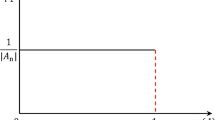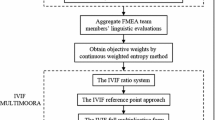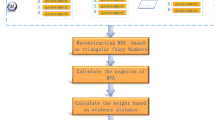Abstract
As an efficient assessment technique, failure mode and effects analysis (FMEA) plays a critical role in conducting risk analyses of production and decision-making. In FMEA, the determination of the risk priority number (RPN) is the most important stage used to prioritize potential failure modes. However, the elicited RPN oftentimes contains uncertainty. Information fractal dimension is a measure of uncertainty and complexity for probability distributions. Therefore, this paper aims to propose a novel exponential information fractal dimension weighted RPN (IFDRPN). Probability distributions of assessments are provided by experts. Then, the information fractal dimension is calculated with the consideration of the uncertainty of each piece of assessment information. Furthermore, the relative importance of experts based on variable backgrounds and authorities is also taken into consideration. The corresponding FMEA is capable of measuring uncertainty and complexity in opinions for failure modes to facilitate assessment. An application of rotor blades for an aircraft turbine, along with the risk assessment in hydropower finance project, are used to demonstrate the effectiveness of the proposed FMEA approach.





Similar content being viewed by others
Data Availability
The code of the current study are available from the corresponding author on reasonable request
References
Srivastava AK, Kumar S, Zareapoor M (2018) Self-organized design of virtual reality simulator for identification and optimization of healthcare software components. J Ambient Intell Human Comput. https://doi.org/10.1007/s12652-018-1100-0
Abualigah L, Diabat A, Elaziz MA (2023) Improved slime mould algorithm by opposition-based learning and levy flight distribution for global optimization and advances in real-world engineering problems. J Ambient Intell Human Comput 14(2):1163–1202
Dhavakumar P, Gopalan NP (2021) An efficient parameter optimization of software reliability growth model by using chaotic grey wolf optimization algorithm. J Ambient Intell Human Comput 12(2):3177–3188
Chen X, Deng Y (2022) An evidential software risk evaluation model. Mathematics 10(13). https://doi.org/10.3390/math10132325
Chen X, Deng Y (2023) A new belief entropy and its application in software risk analysis. Intern J Comput Commun Control 18(2):5299. https://doi.org/10.15837/ijccc.2023.2.5299
Xiao F, Pedrycz W (2023) Negation of the quantum mass function for multisource quantum information fusion with its application to pattern classification. IEEE Trans Pattern Anal Mach Intell 45(2):2054–2070. https://doi.org/10.1109/TPAMI.2022.3167045
Xiao F (2023) Generalized quantum evidence theory. Appl Intell 53(11):14329–14344. https://doi.org/10.1007/s10489-022-04181-0
Pan L, Gao X (2023) Evidential markov decision-making model based on belief entropy to predict interference effects. Inf Sci 633:10–26. https://doi.org/10.1016/j.ins.2023.03.059
Benamrane A, Benelallam I, Bouyakhf EH (2020) Constraint programming based techniques for medical resources optimization: medical internships planning. J Ambient Intell Human Comput 11(9):3801–3810
Talaat FM, Saraya MS, Saleh AI, Ali HA, Ali SH (2020) A load balancing and optimization strategy (LBOS) using reinforcement learning in fog computing environment. J Ambient Intell Human Comput 11(11):4951–4966. https://doi.org/10.1007/s12652-020-01768-8
Jin C, Ran Y, Zhang G (2021) An improving failure mode and effect analysis method for pallet exchange rack risk analysis. Soft Comput 25(24):15221–15241. https://doi.org/10.1007/s00500-021-06359-z
Wang L, Hu Y-P, Liu H-C, Shi H (2019) A linguistic risk prioritization approach for failure mode and effects analysis: A case study of medical product development. Qual Reliab Eng Int 35(6):1735–1752
Fattahi R, Tavakkoli-Moghaddam R, Khalilzadeh M, Shahsavari-Pour N, Soltani R (2020) A novel FMEA model based on fuzzy multiplecriteria decision-making methods for risk assessment. J Enterp Inf Manag 33(5):881–904
Huang J, Xu D-H, Liu H-C, Song M-S (2021) A new model for failure mode and effect analysis integrating linguistic Z-numbers and projection method. IEEE Trans Fuzzy Syst 29(3):530–538. https://doi.org/10.1109/TFUZZ.2019.2955916
Zeng Y, Li Y-F, Huang J, Hao X, Chen H, Huang H-Z (2020) Reliability analysis for photoelectric pods based on FMEA. In: 2020 Global Reliability and Prognostics and Health Management (PHM-Shanghai), pp. 1–5. https://doi.org/10.1109/PHM-Shanghai49105.2020.9280934
Zhang H, Dong Y, Palomares-Carrascosa I, Zhou H (2018) Failure mode and effect analysis in a linguistic context: A consensus-based multiattribute group decision-making approach. IEEE Trans Reliab 68(2):566–582
Chanamool N, Naenna T (2016) Fuzzy FMEA application to improve decision-making process in an emergency department. Appl Soft Comput 43:441–453. https://doi.org/10.1016/j.asoc.2016.01.007
Gao K, Wang Y, Ma L (2022) Belief entropy tree and random forest: Learning from data with continuous attributes and evidential labels. Entropy 24(5). https://doi.org/10.3390/e24050605
Zhang Q, Li M (2022) A betweenness structural entropy of complex networks. Chaos, Solitons & Fractals 161:112264. https://doi.org/10.1016/j.chaos.2022.112264
Huang G, Xiao L, Zhang G (2021) Risk evaluation model for failure mode and effect analysis using intuitionistic fuzzy rough number approach. Soft Comput 25(6):4875–4897
Vahdani B, Salimi M, Charkhchian M (2015) A new FMEA method by integrating fuzzy belief structure and TOPSIS to improve risk evaluation process. Intern J Adv Manuf Techn 77(1):357–368
Song W, Ming X, Wu Z, Zhu B (2014) A rough TOPSIS approach for failure mode and effects analysis in uncertain environments. Qual Reliab Eng Int 30(4):473–486. https://doi.org/10.1002/qre.1500
Ouyang L, Zheng W, Zhu Y, Zhou X (2020) An interval probabilitybased FMEA model for risk assessment: A real-world case. Qual Reliab Eng Int 36(1):125–143
Fattahi R, Khalilzadeh M (2018) Risk evaluation using a novel hybrid method based on FMEA, extended MULTIMOORA, and AHP methods under fuzzy environment. Saf Sci 102:290–300. https://doi.org/10.1016/j.ssci.2017.10.018
Sant’Anna AP (2012) Probabilistic priority numbers for failure modes and effects analysis. Int J Qual Reliab Manag 29:349–362. https://doi.org/10.1108/02656711211216171
Xiao F, Wen J, Pedrycz W (2023) Generalized divergence-based decision making method with an application to pattern classification. IEEE Trans Knowl Data Eng 35(7):6941–6956. https://doi.org/10.1109/TKDE.2022.3177896
Xiao F, Cao Z, Lin C-T (2022) A complex weighted discounting multisource information fusion with its application in pattern classification. IEEE Trans Knowl Data Eng 1–16. https://doi.org/10.1109/TKDE.2022.3206871
Xiao F (2023) GEJS: A generalized evidential divergence measure for multisource information fusion. IEEE Trans Syst Man Cybern Syst 53(4):2246–2258. https://doi.org/10.1109/TSMC.2022.3211498
Yang J, Huang H-Z, He L-P, Zhu S-P, Wen D (2011) Risk evaluation in failure mode and effects analysis of aircraft turbine rotor blades using Dempster-Shafer evidence theory under uncertainty. Eng Fail Anal 18(8):2084–2092
Tang Y, Zhou D, Chan FT (2018) AMWRPN: Ambiguity measure weighted risk priority number model for failure mode and effects analysis. IEEE Access 6:27103–27110. https://doi.org/10.1109/ACCESS.2018.2836139
Chang K-H, Wen T-C (2010) A novel efficient approach for DFMEA combining 2-tuple and the OWA operator. Expert Syst Appl 37(3):2362–2370. https://doi.org/10.1016/j.eswa.2009.07.026
Chang K-H, Cheng C-H (2011) Evaluating the risk of failure using the fuzzy OWA and DEMATEL method. Journal of Intelligent Manufacturing 22(2):113–129
Bian T, Zheng H, Yin L, Deng Y (2018) Failure mode and effects analysis based on D numbers and TOPSIS. Qual Reliab Eng Int 34:501–515
Yousefi S, Valipour M, Gul M (2021) Systems failure analysis using Znumber theory-based combined compromise solution and full consistency method. Appl Soft Comput 113:107902. https://doi.org/10.1016/j.asoc.2021.107902
Liu H-C, Wang L-E, Li Z, Hu Y-P (2019) Improving risk evaluation in FMEA with cloud model and hierarchical TOPSIS method. IEEE Trans Fuzzy Syst 27(1):84–95. https://doi.org/10.1109/TFUZZ.2018.2861719
Huang J, You J-X, Liu H-C, Song M-S (2020) Failure mode and effect analysis improvement: A systematic literature review and future research agenda. Reliab Eng Syst Saf 199:106885. https://doi.org/10.1016/j.ress.2020.106885
R’enyi A (1960) Dimension, entropy and information. Trans Prague Conf Inf Theory, 545–556
Wen T, Jiang W (2018) An information dimension of weighted complex networks. Physica A: Statistical Mechanics and its Applications 501:388–399
Zhu R, Chen J, Kang B (2020) Power law and dimension of the maximum value for belief distribution with the maximum Deng entropy. IEEE Access 8:47713–47719
Gao Q, Wen T, Deng Y (2021) Information volume fractal dimension. Fractals 29(8):2150263. https://doi.org/10.1142/S0218348X21502637
Lei M (2022) Information dimension based on deng entropy. Physica Astatistical Mechanics And Its Applications 600. https://doi.org/10.1016/j.physa.2022.127584
Qiang C, Deng Y, Cheong KH (2022) Information fractal dimension of mass function. Fractals 30(06):2250110. https://doi.org/10.1142/S0218348X22501109
Qiang C, Li Z, Deng Y (2023) Multifractal analysis of mass function. Soft Comput. https://doi.org/10.1007/s00500-023-08502-4
Zhou D, Tang Y, Jiang W (2016) A modified model of failure mode and effects analysis based on generalized evidence theory. Math Probl Eng 2016:4512383. https://doi.org/10.1155/2016/4512383
Wu Q, Deng Y, Xiong N (2022) Exponential negation of a probability distribution. Soft Comput 26(3):2147–2156
Spasenic Z, Makajic-Nikolic D, Benkovic S (2022) Risk assessment of financing renewable energy projects: A case study of financing a small hydropower plant project in serbia. Energy Reports 8:8437–8450. https://doi.org/10.1016/j.egyr.2022.06.065
Acknowledgements
The work is partially supported by National Natural Science Foundation of China (Grant No. 61973332), JSPS Invitational Fellowships for Research in Japan (Short-term)
Funding
The work was partially supported by National Natural Science Foundation of China (Grant No. 61973332), JSPS Invitational Fellowships for Research in Japan (Short-term)
Author information
Authors and Affiliations
Contributions
All authors contributed to the study conception and design. All authors performed material preparation, data collection and analysis. Liu Ruijie wrote the first draft of the paper. All authors contributed to the revisions of the paper. All authors read and approved the final manuscript
Corresponding author
Ethics declarations
Conflict of interest/Competing interests
All the authors certify that there is no conflict of interest with any individual or organization for this work
Ethics approval
This article does not contain any studies with human participants or animals performed by any of the authors
Consent to participate
Informed consent was obtained from all individual participants included in the study
Consent for publication
The participant has consented to the submission of the case report to the journal
Additional information
Publisher's Note
Springer Nature remains neutral with regard to jurisdictional claims in published maps and institutional affiliations.
Rights and permissions
Springer Nature or its licensor (e.g. a society or other partner) holds exclusive rights to this article under a publishing agreement with the author(s) or other rightsholder(s); author self-archiving of the accepted manuscript version of this article is solely governed by the terms of such publishing agreement and applicable law.
About this article
Cite this article
Liu, R., Li, Z. & Deng, Y. Exponential information fractal dimension weighted risk priority number method for failure mode and effects analysis. Appl Intell 53, 25058–25069 (2023). https://doi.org/10.1007/s10489-023-04912-x
Accepted:
Published:
Issue Date:
DOI: https://doi.org/10.1007/s10489-023-04912-x




